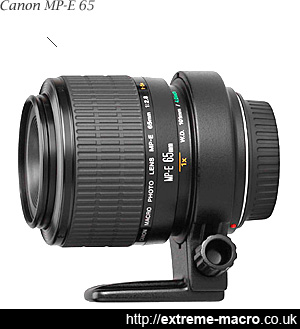Choosing Your Brand
by Johan J Ingles-Le Nobel
Last updated August 31, 2017
The best extreme macro brand is Canon, plain and simple. Photographers are incredibly tribal when it comes to their brand of equipment, but Canon is the only brand that takes extreme macro seriously.
Much as it pains me to say this as a Pentax user myself, if you're really planning to do a lot of extreme macro, save yourself a billion headaches by buying into the Canon system if you can. I'm tempted daily, but can't afford to.

Canon, easily the best camera system for extreme macro.
Canon MP-E 65mm

The Canon MP-E 65mm lens is without peer in the extreme macro world, zooming from 1:1 to 5:1 in a single lens. No other brand has a lens like it, which is why the Canon system comes out top for extreme macro.
The Canon MP-E 65mm lens is without peer in the extreme macro world, zooming from 1:1 to 5:1 in a single lens. No other brand has a lens like it, which is why the Canon system comes out top for extreme macro. In specialist extreme macro lens comparisons, the Canon MP-E 65 scores extremely well against the best optics of any type for optical quality in the 1:1 to 5:1 range. The convenience of having this range in a single package is unparalleled, although there are ways to achieve something quite similar to MPE on any other brand.
Canon MT-24EX Flash
Canon have not just produced the finest extreme macro lens but they have also complimented it with a flash unit designed for the working distance and positioning needed for extreme macro. The Canon MT-24EX Flashh is the Mpe-65's companion, a twin flash unit on which each flash head can be individually tilted in and out. The MT-24EX Flash contains most of the features found on high end flash systems including flash exposure compensation, flash exposure bracketing, high speed synch and a flash output ratio (8:1 to 1:8 in 13 1/2 stop steps).
Canon EFSC
EFSC replaces a mechanical shutter with an electronic shutter, eliminating vibrationWith both mirrors and shutters causing vibration issues at high magnification, Canon's adoption of EFSC (Electronic First Shutter Curtain) as an option in some of its bodies make it the leading brand for extreme magnification photography with, for example x50 microscope objectives. EFSC replaces a mechanical shutter with an electronic shutter, eliminating vibration. This feature is optional on the 40D, 50D, 5DII, and 7D but also exists, albeit as a default only, on the Rebel XSi/450D, Rebel XS/1000D, and Rebel T1i/500D DSLRs. The evidence is clear that it improves microscopy photography, although EFSC is not without its own issues. Beware, EFSC is just for continuous lighting, EFSC is not usable with flash.
As an addendum EFSC is now also employed by Pentax in some of its latest bodies the K3ii and K1. EFSC is employed with a delay mode set and in pixelshift mode. There is no way to obtain EFSC without pixelshift.
Canon Full Frame
Whilst most brands now offer full-frame digital bodies, not all do, but Canon has always led the way in this aspect. This gives the extreme macro photographer a larger field of view to work with, meaning for example you can show more with your expensive Mitutuyo objective. This is useful for MPE65 as well, because it means that you can photograph larger insects. Many photographers have said that 1:2 to 4:1 is probably a preferred range for MPE65 than 1:1 to 5:1.
Canon Accessories
There are more accessories and third party components available for Canon than for any other brand of camera. This may not be an immediately obvious advantage in extreme macro in which we tend to make many of our components, but in the long run this has cost and availability implications, as I have regularly found out being a Pentax user myself, struggling to find certain lenses or parts easily available in Canon mount. Maybe I need to switch to Canon. An example of this is the Sigma 180mm macro. It has been discontinued in Pentax mount and used copies now go for upwards of £1000. In Canon mount, the same lens goes for £300. This is doubly tricky for Pentax users, because the choice of 200mm lenses is very limited.
Bonus Reason: Inbuilt Stacking
It looks like Canon's philosophy of opening up its API is bearing fruit as there are now interfaces and hardwares starting to appear to make in-camera stacking a reality on Canon cameras. Both Magic Lantern and Promote Control look like interesting stacking options for Canon users. That said, it should be noted that Magic Lantern does its stacking by adjusting focus on a lens, which cannot be used with MPE65 as there is no focus ring on that lens.
Related Articles




